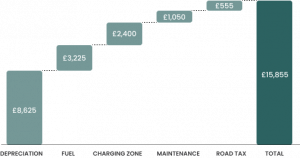Making Data-Driven Decisions: Using NPV to Calculate Fleet Total Cost of Ownership
As organisations increasingly prioritise sustainability and cost-effectiveness, fleet managers are exploring ways to optimise Total Cost of Ownership (TCO) for their vehicle fleets. With the rising adoption of electric vehicles (EVs), fleet managers need a reliable financial metric to assess the cost savings of transitioning to electric. This is where Net Present Value (NPV) comes into play, offering valuable insights for making data-driven decisions that align with long-term financial and environmental goals.
Understanding Fleet Total Cost of Ownership: Fleet TCO encompasses all expenses associated with owning and operating a fleet, including;
- Lease/ depreciation costs
Fuel prices
- Ownership period
- Mileage
- Maintenance
- Taxes
- Clean air zone fees.
Accurately estimating TCO is essential to determine the financial viability of a fleet transition to EVs.
The Power of Net Present Value (NPV): NPV is a financial tool that calculates the profitability of an investment over time, considering the time value of money. By taking into account future cash flows and discounting them back to the present value, NPV provides a clear picture of the investment’s financial impact.
Calculating NPV for Fleet TCO: To calculate NPV for fleet TCO, identify all cash flows involved in owning and operating the fleet over its lifespan. These include the costs mentioned, which can be both positive (cash inflow) and negative (cash outflow). Next, determine the appropriate discount rate that reflects the risk and investment objectives. The higher the discount rate, the more weight is given to the present value of cash flows.
NPV = Σ [CFt / (1 + r)^t]
Where: NPV = Net Present Value CFt = Cash flow in year, r = Discount rate, t = Year of the cash flow
Interpreting the Results: A positive NPV indicates that the transition to EVs results in a financially viable decision, providing cost savings over time. On the other hand, a negative NPV might suggest that the investment might not be economically beneficial. It is essential to consider the magnitude of the NPV; a higher positive NPV indicates more financially attractive savings.
By utilizing NPV for fleet TCO calculations, fleet managers can make informed decisions based on solid financial analysis. NPV empowers managers to identify the best-suited electric vehicles for the fleet, optimise the ownership period, and evaluate the financial impact of various cost variables.

 Fuel prices
Fuel prices